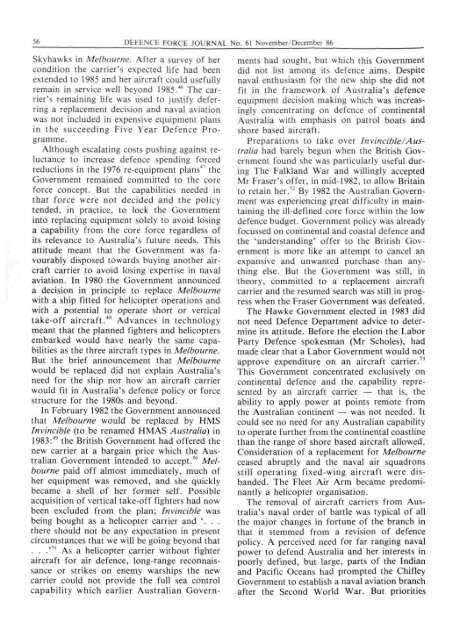ISSUE 61 : Nov/Dec - 1986 - Australian Defence Force Journal
ISSUE 61 : Nov/Dec - 1986 - Australian Defence Force Journal
ISSUE 61 : Nov/Dec - 1986 - Australian Defence Force Journal
Create successful ePaper yourself
Turn your PDF publications into a flip-book with our unique Google optimized e-Paper software.
56 DEFENCE FORCE JOURNAL No. <strong>61</strong> <strong>Nov</strong>ember/<strong>Dec</strong>ember 86<br />
Skyhawks in Melbourne. After a survey of her<br />
condition the carrier's expected life had been<br />
extended to 1985 and her aircraft could usefully<br />
remain in service well beyond 1985.* 6 The carrier's<br />
remaining life was used to justify deferring<br />
a replacement decision and naval aviation<br />
was not included in expensive equipment plans<br />
in the succeeding Five Year <strong>Defence</strong> Programme.<br />
Although escalating costs pushing against reluctance<br />
to increase defence spending forced<br />
reductions in the 1976 re-equipment plans 47 the<br />
Government remained committed to the core<br />
force concept. But the capabilities needed in<br />
that force were not decided and the policy<br />
tended, in practice, to lock the Government<br />
into replacing equipment solely to avoid losing<br />
a capability from the core force regardless of<br />
its relevance to Australia's future needs. This<br />
attitude meant that the Government was favourably<br />
disposed towards buying another aircraft<br />
carrier to avoid losing expertise in naval<br />
aviation. In 1980 the Government announced<br />
a decision in principle to replace Melbourne<br />
with a ship fitted for helicopter operations and<br />
with a potential to operate short or vertical<br />
take-off aircraft. 48 Advances in technology<br />
meant that the planned fighters and helicopters<br />
embarked would have nearly the same capabilities<br />
as the three aircraft types in Melbourne.<br />
But the brief announcement that Melbourne<br />
would be replaced did not explain Australia's<br />
need for the ship nor how an aircraft carrier<br />
would fit in Australia's defence policy or force<br />
structure for the 1980s and beyond.<br />
In February 1982 the Government announced<br />
that Melbourne would be replaced by HMS<br />
Invincible (to be renamed HMAS Australia) in<br />
1983: 49 the British Government had offered the<br />
new carrier at a bargain price which the <strong>Australian</strong><br />
Government intended to accept. 50 Melbourne<br />
paid off almost immediately, much of<br />
her equipment was removed, and she quickly<br />
became a shell of her former self. Possible<br />
acquisition of vertical take-off fighters had nowbeen<br />
excluded from the plan; Invincible was<br />
being bought as a helicopter carrier and '. . .<br />
there should not be any expectation in present<br />
circumstances that we will be going beyond that<br />
. . .'" As a helicopter carrier without fighter<br />
aircraft for air defence, long-range reconnaissance<br />
or strikes on enemy warships the new<br />
carrier could not provide the full sea control<br />
capability which earlier <strong>Australian</strong> Governments<br />
had sought, but which this Government<br />
did not list among its defence aims. Despite<br />
naval enthusiasm for the new ship she did not<br />
fit in the framework of Australia's defence<br />
equipment decision making which was increasingly<br />
concentrating on defence of continental<br />
Australia with emphasis on patrol boats and<br />
shore based aircraft.<br />
Preparations to take over Invincible/Australia<br />
had barely begun when the British Government<br />
found she was particularly useful during<br />
The Falkland War and willingly accepted<br />
Mr Fraser's offer, in mid-1982, to allow Britain<br />
to retain her." By 1982 the <strong>Australian</strong> Government<br />
was experiencing great difficulty in maintaining<br />
the ill-defined core force within the low<br />
defence budget. Government policy was already<br />
focussed on continental and coastal defence and<br />
the 'understanding' offer to the British Government<br />
is more like an attempt to cancel an<br />
expansive and unwanted purchase than anything<br />
else. But the Government was still, in<br />
theory, committed to a replacement aircraft<br />
carrier and the resumed search was still in progress<br />
when the Fraser Government was defeated.<br />
The Hawke Government elected in 1983 did<br />
not need <strong>Defence</strong> Department advice to determine<br />
its attitude. Before the election the Labor<br />
Party <strong>Defence</strong> spokesman (Mr Scholes), had<br />
made clear that a Labor Government would not<br />
approve expenditure on an aircraft carrier. 53<br />
This Government concentrated exclusively on<br />
continental defence and the capability represented<br />
by an aircraft carrier — that is, the<br />
ability to apply power at points remote from<br />
the <strong>Australian</strong> continent — was not needed. It<br />
could see no need for any <strong>Australian</strong> capability<br />
to operate further from the continental coastline<br />
than the range of shore based aircraft allowed.<br />
Consideration of a replacement for Melbourne<br />
ceased abruptly and the naval air squadrons<br />
still operating fixed-wing aircraft were disbanded.<br />
The Fleet Air Arm became predominantly<br />
a helicopter organisation.<br />
The removal of aircraft carriers from Australia's<br />
naval order of battle was typical of all<br />
the major changes in fortune of the branch in<br />
that it stemmed from a revision of defence<br />
policy. A perceived need for far ranging naval<br />
power to defend Australia and her interests in<br />
poorly defined, but large, parts of the Indian<br />
and Pacific Oceans had prompted the Chifley<br />
Government to establish a naval aviation branch<br />
after the Second World War. But priorities

















